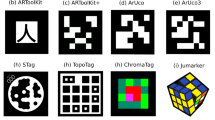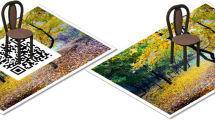Abstract
Fiducial markers are visual objects that can be placed in the field of view of an imaging sensor to determine its position and orientation, and subsequently the scale and position of other objects within the same field of view. They are used in a wide variety of applications ranging from medical applications to augmented reality (AR) solutions where they are applied to determine the location of an AR headset. Despite the wide range of different marker types with their advantages for specific use cases, there exists no standard to decide which marker to best use in which situation. This leads to proprietary AR solutions that rely on a predefined set of marker and pose detection algorithms, preventing interoperability between AR applications. We propose the FidMark fiducial marker ontology, classifying and describing the different markers available for computer vision and augmented reality along with their spatial position and orientation. Our proposed ontology also describes the procedures required to perform pose estimation, and marker detection to allow the description of algorithms used to perform these procedures. With FidMark we aim to enable future AR solutions to semantically describe markers within an environment so that third-party applications can utilise this information.
Access this chapter
Tax calculation will be finalised at checkout
Purchases are for personal use only
Similar content being viewed by others
Notes
- 1.
For more information about the ontology profile and ontology statistics, please check the online documentation.
- 2.
- 3.
- 4.
- 5.
References
Barone Rodrigues, A., Dias, D.R.C., Martins, V.F., Bressan, P.A., de Paiva Guimarães, M.: WebAR: a web-augmented reality-based authoring tool with experience API support for educational applications. In: Antona, M., Stephanidis, C. (eds.) UAHCI 2017. LNCS, vol. 10278, pp. 118–128. Springer, Cham (2017). https://doi.org/10.1007/978-3-319-58703-5_9
Battle, R., Kolas, D.: GeoSPARQL: enabling a geospatial semantic web. Semant. Web J. 3(4) (2011)
Bermudez, F.F., Diaz, C.S., Ward, S., Radkowski, R., Garrett, T., Oliver, J.: Comparison of natural feature descriptors for rigid-object tracking for real-time augmented reality. In: Proceedings of the 34th Computers and Information in Engineering Conference, Buffalo, USA (2014). https://doi.org/10.1115/DETC2014-35319
Bradski, G.: The OpenCV library. Dr. Dobb’s J. Softw. Tools Prof. Programmer 25(11) (2000)
Calvet, L., Gurdjos, P., Griwodz, C., Gasparini, S.: Detection and accurate localization of circular fiducials under highly challenging conditions. In: Proceedings of the IEEE Conference on Computer Vision and Pattern Recognition (CVPR 2016) (2016). https://openaccess.thecvf.com/content_cvpr_2016/html/Calvet_Detection_and_Accurate_CVPR_2016_paper.html
Collins, T., Bartoli, A.: Infinitesimal plane-based pose estimation. Int. J. Comput. Vis. 109(3) (2014). https://doi.org/10.1007/s11263-014-0725-5
Díaz, A., Caicedo, S., Caicedo, E.: Augmented reality without fiducial markers. In: Proceedings of the 20th Symposium on Signal Processing, Images and Computer Vision (STSIVA 2015) (2015). https://doi.org/10.1109/STSIVA.2015.7330431
Gao, X.S., Hou, X.R., Tang, J., Cheng, H.F.: Complete solution classification for the perspective-three-point problem. IEEE Trans. Pattern Anal. Mach. Intell. 25(8) (2003). https://doi.org/10.1109/TPAMI.2003.1217599
Garrido-Jurado, S., Muñoz-Salinas, R., Madrid-Cuevas, F.J., Marín-Jiménez, M.J.: Automatic generation and detection of highly reliable fiducial markers under occlusion. Pattern Recogn. 47(6) (2014). https://doi.org/10.1016/j.patcog.2014.01.005
Gsaxner, C., Li, J., Pepe, A., Schmalstieg, D., Egger, J.: Inside-out instrument tracking for surgical navigation in augmented reality. In: Proceedings of the 27th ACM Symposium on Virtual Reality Software and Technology (VRST 2021) (2021). https://doi.org/10.1145/3489849.3489863
Guha, R.V., Brickley, D., Macbeth, S.: Schema.org: evolution of structured data on the web. Commun. ACM 59(2) (2016). https://doi.org/10.1145/2844544
Gyrard, A., Datta, S.K., Bonnet, C., Boudaoud, K.: Cross-domain internet of things application development: M3 framework and evaluation. In: Proceedings of the 3rd International Conference on Future Internet of Things and Cloud (FiCloud 2015) (2015). https://doi.org/10.1109/FiCloud.2015.10
Hogan, A.: Shape constraints and expressions. In: Hogan, A. (ed.) The Web of Data, pp. 449–513. Springer, Cham (2020). https://doi.org/10.1007/978-3-030-51580-5_7
ISO Central Secretary: Photography – Archiving Systems: Vocabulary. Standard ISO 19262:2015, International Organization for Standardization (2015). https://www.iso.org/standard/64219.html
ISO Central Secretary: Geographic information – Imagery Sensor Models for Geopositioning. Standard ISO 19130-1:2018, International Organization for Standardization (2018). https://www.iso.org/standard/66847.html
ISO Central Secretary: Geographic Information – Referencing by Coordinates. Standard ISO 19111:2019, International Organization for Standardization (2019). https://www.iso.org/standard/74039.html
ISO Central Secretary: Information technology – Automatic Identification and Data Capture Techniques. Standard ISO 18004:2015, International Organization for Standardization (2021). https://www.iso.org/standard/62021.html
Janowicz, K., Haller, A., Cox, S.J., Le Phuoc, D., Lefrançois, M.: SOSA: a lightweight ontology for sensors, observations, samples, and actuators. J. Web Semant. 56 (2019). https://doi.org/10.1016/j.websem.2018.06.003
Kahn, C.E., Jr., Langlotz, C.P., Channin, D.S., Rubin, D.L.: Informatics in radiology: an information model of the DICOM standard. Radiographics 31(1) (2011). https://doi.org/10.1148/rg.311105085
Kalaitzakis, M., Cain, B., Carroll, S., Ambrosi, A., Whitehead, C., Vitzilaios, N.: Fiducial markers for pose estimation: overview, applications and experimental comparison of the ARTag, AprilTag, ArUco and STag Markers. J. Intell. Robot. Syst. 101 (2021). https://doi.org/10.1007/s10846-020-01307-9
Kaltenbrunner, M., Bencina, R.: reacTIVision: a computer-vision framework for table-based tangible interaction. In: Proceedings of the 1st International Conference on Tangible and Embedded interaction (TEI 2007), Baton Rouge, USA (2007). https://doi.org/10.1145/1226969.1226983
Ke, T., Roumeliotis, S.I.: An efficient algebraic solution to the perspective-three-point problem. In: Proceedings of the IEEE Conference on Computer Vision and Pattern Recognition (CVPR 2017) (2017)
Košt’ák, M., Slabỳ, A.: Designing a simple fiducial marker for localization in spatial scenes using neural networks. Sensors 21(16) (2021). https://doi.org/10.3390/s21165407
Lepetit, V., Moreno-Noguer, F., Fua, P.: EPnP: an accurate O(n) solution to the PnP problem. Int. J. Comput. Vis. 81 (2009). https://doi.org/10.1007/s11263-008-0152-6
Marchand, E., Uchiyama, H., Spindler, F.: Pose estimation for augmented reality: a hands-on survey. IEEE Trans. Vis. Comput. Graph. 22(12), 2633–2651 (2015). https://doi.org/10.1109/TVCG.2015.2513408
Mráz, E., Rodina, J., Babinec, A.: Using fiducial markers to improve localization of a drone. In: Proceedings of the 23rd International Symposium on Measurement and Control in Robotics (ISMCR 2020), Budapest, Hungary (2020). https://doi.org/10.1109/ISMCR51255.2020.9263754
Murphy-Chutorian, E., Trivedi, M.M.: Head pose estimation in computer vision: a survey. IEEE Trans. Pattern Anal. Mach. Intell. 31(4) (2008). https://doi.org/10.1109/TPAMI.2008.106
Nöll, T., Pagani, A., Stricker, D.: Markerless camera pose estimation: an overview. In: Proceedings of the Workshop on Visualization of Large and Unstructured Data Sets (VLUDS 2010), Dagstuhl, Germany (2010). https://doi.org/10.4230/OASIcs.VLUDS.2010.45
Odmins, J., Slics, K., Fenuks, R., Linina, E., Osmanis, K., Osmanis, I.: Comparison of passive and active fiducials for optical tracking. Latvian J. Phys. Tech. Sci. 59(5) (2022). https://doi.org/10.2478/lpts-2022-0040
Olson, E.: AprilTag: a robust and flexible visual fiducial system. In: Proceedings of the IEEE International Conference on Robotics and Automation (ICRA 2011), Shanghai, China (2011). https://doi.org/10.1109/ICRA.2011.5979561
Poveda-Villalón, M., Fernández-Izquierdo, A., Fernández-López, M., García-Castro, R.: LOT: an industrial oriented ontology engineering framework. Eng. Appl. Artif. Intell. 111 (2022). https://doi.org/10.1016/j.engappai.2022.104755
Poveda-Villalón, M., Gómez-Pérez, A., Suárez-Figueroa, M.C.: OOPS! (OntOlogy Pitfall Scanner!): an on-line tool for ontology evaluation. Int. J. Semant. Web Inf. Syst. (IJSWIS) 10(2) (2014). https://doi.org/10.4018/ijswis.2014040102
Roberts, G.W., et al.: The use of augmented reality, GPS and INS for subsurface data visualization. In: Proceedings of the 22nd International FIG Congress (2002)
Sirin, E., Parsia, B., Grau, B.C., Kalyanpur, A., Katz, Y.: Pellet: a practical OWL-DL reasoner. J. Web Semant. 5(2) (2007). https://doi.org/10.1016/j.websem.2007.03.004
Song, K.T., Chang, Y.C.: Design and implementation of a pose estimation system based on visual fiducial features and multiple cameras. In: Proceedings of the International Automatic Control Conference (CACS 2018), Taoyuan, Taiwan (2018). https://doi.org/10.1109/CACS.2018.8606773
Ulrich, J., Alsayed, A., Arvin, F., Krajník, T.: Towards fast fiducial marker with full 6 DOF pose estimation. In: Proceedings of the 37th ACM/SIGAPP Symposium on Applied Computing (SAC 2022), Virtual Event (2022). https://doi.org/10.1145/3477314.3507043
Urtans, E., Nikitenko, A.: Active infrared markers for augmented and virtual reality. Eng. Rural Dev. 9, 10 (2016). https://api.semanticscholar.org/CorpusID:29944026
Wagner, A., Bonduel, M., Pauwels, P., Uwe, R.: Relating geometry descriptions to its derivatives on the web. In: Proceedings of the European Conference on Computing in Construction, Chania, Greece (2019). https://doi.org/10.35490/ec3.2019.146
Van de Wynckel, M., Signer, B.: OpenHPS: an open source hybrid positioning system. Technical report. WISE-2020-01, Vrije Universiteit Brussel (2020). https://doi.org/10.48550/ARXIV.2101.05198
Van de Wynckel, M., Signer, B.: POSO: a generic positioning system ontology. In: Sattler, U., et al. (eds.) ISWC 2022. LNCS, vol. 13489, pp. 231–247. Springer, Cham (2022). https://doi.org/10.1007/978-3-031-19433-7_14
Acknowledgements
The research of Isaac Valadez has been funded by a Baekeland mandate of Flanders Innovation & Entrepreneurship (VLAIO, HBC.2020.2881).
Author information
Authors and Affiliations
Corresponding author
Editor information
Editors and Affiliations
Rights and permissions
Copyright information
© 2024 The Author(s), under exclusive license to Springer Nature Switzerland AG
About this paper
Cite this paper
Van de Wynckel, M., Valadez, I., Signer, B. (2024). FidMark: A Fiducial Marker Ontology for Semantically Describing Visual Markers. In: Meroño Peñuela, A., et al. The Semantic Web. ESWC 2024. Lecture Notes in Computer Science, vol 14665. Springer, Cham. https://doi.org/10.1007/978-3-031-60635-9_14
Download citation
DOI: https://doi.org/10.1007/978-3-031-60635-9_14
Published:
Publisher Name: Springer, Cham
Print ISBN: 978-3-031-60634-2
Online ISBN: 978-3-031-60635-9
eBook Packages: Computer ScienceComputer Science (R0)




